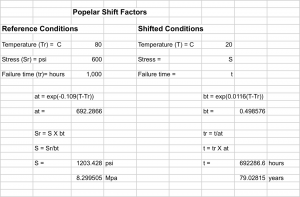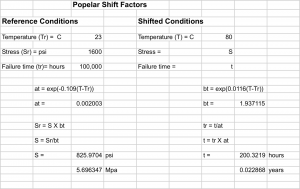December 2014, Vol. 241, No. 12
Features
Determining Design Life Of Assemblies Of Polyethylene Pipe

Improvements in long-term performance of polyethylene (PE) piping compounds have created interest in the use of higher operating pressures for gas distribution piping systems.
In Canada, this has culminated in the approval of PE 100 pipe with an operating pressure of 145 pounds per square inch gage (psig) for SDR 11 pipe, and the approval of PE 2708 PLUS and PE 4710 PLUS compounds that qualify for a 0.45 design factor for gas applications.
In the United States, the American Gas Association (AGA) has submitted a petition to the Pipeline and Hazardous Materials Safety Administration (PHMSA) looking to increase the design factor from 0.32 to 0.40. When the 0.40 design factor is approved, SDR 11 PE 4710 pipe with an American Society for Testing and Materials (ASTM) D 2837 HDB of 1,600 psi can be operated up to 125 psig (calculated value is 128 psig). However, the Department of Transportations (DOT) limit for PE is 125 psig for gas applications.
It is clear from these initiatives there is growing interest in the safe operation of high-performance PE 2708 and PE 4710 gas piping systems at higher system operating pressures. However, gas companies recognize that the ASTM D 2837 pressure-rating method is for pipe only. The companies would like piping systems to include heat-fusion fittings and joints, such as PE socket-fusion, saddle-fusion, butt-fusion and electro-fusion fittings.
Utilities would like a methodology to determine the design life of their entire system (PE heat-fusion fittings that are joined to PE pipe) that will operate at these higher pressures.
We are using the term “design life” to mean the minimum desired time that the assembly will last at its maximum operating stress and average annual operating temperature based on just the internal pressure. With this methodology, possible effects of additional secondary loads, such as bending, deflection and rock impingement can be considered.
This methodology can determine design life for PE heat-fusion fittings joined to PE pipe used in gas distribution applications. All types of mechanical fittings, whether made of metal or plastic, are excluded. The methodology determines design life for the assembly of PE fittings joined by heat fusion to PE pipe only.
Maximum Operating Pressures
The Canadian Oil and Gas Code – CSA Z662-11 allows use of a 0.45 design factor for PE compounds with very high resistance to slow crack growth and rapid crack propagation. It also allows the use of PE 100 with a design coefficient of 2.0. With these recent changes made to Canadian gas piping standards, the maximum operating pressures allowed for various SDR 11 PE pipes are as follows:
PE 100 – (2.0 design coefficient) 145 psig
PE 4710 – (0.45 design factor) 145 psig
PE 4710 – (0.40 design factor) 125 psig
PE 2708 – (0.45 design factor) 112 psig
PE 2708 – (0.40 design factor) 100 psig
The maximum operating pressures, using a 0.40 design factor, will be permitted in the United States once the AGA petition to PHMSA is approved.
The proposed methodology can be used for any gas company operating pressure (stress) and its average annual ground temperature. For example, an operating pressure of 145 psig for SDR 11 pipe will be used. This is a hoop stress of 725 psi and an average annual ground temperature of 20ºC (68ºF). We will then determine the desired design life for heat-fusion fittings operating at this stress/temperature.
For this example, a design life of 100 years is used, but any design life may be selected using this methodology. Mechanical fittings may be used at these higher pressures, but the design life methodology is not applicable for mechanical fittings. It should be noted the methodology is also applicable to pipe and assemblies.
The heat-fusion joint between the pipe and the fitting is a key element of the assembly. If the utility is interested in the design life of a properly assembled pipe and fitting, then all the tested assemblies should be properly made. However, this methodology could be useful in investigating improperly made heat-fusion joints. It could also be used to determine if a change to a procedure, pipe or a fitting has a positive or negative effect.
Bidirectional Shift Factor
In order to determine a design life of 100 years for PE pipe and heat-fusion fittings at a stress of 725 psi and an average annual ground temperature of 20ºC (68º F), the bidirectional shift factor (BSF) is used. This is a well-known projection methodology in the pressure pipe industry.
Stress rupture data used to develop these shift factors included MDPE, unimodal, high-density polyethylene (HDPE) and bimodal HDPE materials. These materials are classified as PE 2708, PE 3608 and PE 4710. BSF is one of the main methods to validate the hydrostatic design basis (HDB) obtained using ASTM D 2837. An example is shown in Figure 1 for a PE material with an HDB of 1,600 psi at 23ºC (73ºF). The HDB is the categorized stress at 100,000 hours, as defined in ASTM D 2837.
To validate this HDB of 1,600 psi, ASTM D 2837 provides a table with elevated temperature, sustained-pressure requirements. The table is based on the bidirectional shifting of time and stress as the temperature changed. In this case, the HDB at 23º C is bidirectionally shifted to 80º C (Figure 2).
Figure 2: ASTM D 2837 Validation of 1,600 psi HDB.

Based on the bidirectional shift, a time of 200 hours, at a stress of 825 psi and a temperature of 80º C is equivalent to 100,000 hours at a stress of 1,600 psi at 23º C. When pipe samples tested at 80º C with 825 psi for 200 hours, the HDB of 1,600 psi at 100,000 hours and 23º C is validated.
Design Life For Fusion Pipe, Fittings
To determine a 100-year design life for PE heat-fusion fittings in the example, the same principles of BSF are used for HDB validation. In this case, we are trying to validate a stress of 725 psi (145 psig for SDR 11 pipe), at a temperature of 20ºC over 100 years. The 20ºC/725 psi line (red line in Figure 3) and 100 years at the end of that red line.
Figure 3: 725 psi/ 20ºC stress line

The time of 876,000 hours and stress of 725 psi at 20º C are then bidirectionally shifted to 80º C to obtain the appropriate test conditions. These shifted values are shown in Figure 4. Note the BSF lines are parallel because the same shift factors are used in both cases.
Figure 4: BSF of 20º C/725 psi over 100 years.

From this bidirectional shifting, observe that testing PE heat-fusion fitting assemblies (fittings joined to pipe) at a temperature of 80ºC and a stress of 363 psi (73 psig for SDR 11 pipe) for a time of 1,275 hours, would be equivalent to the same heat-fusion fittings operated at a stress of 725 psi at a temperature of 20º C for 100 years. As the slow crack growth (slit) failure mode is the long-term failure mode, the failure mode for both the test condition and the projected design life condition are the same slit failure mode.
The design life methodology in the previous example only accounts for the primary load of internal pressure. This methodology could also take into account any additional secondary stresses in service, such as bending or deflection from earth loading. It could also account for improperly fused heat-fusion joints.
This design life methodology could take into account any stress risers inherent in the fitting design, and any manufacturing flaws, such as weak molded knit lines. Any of these secondary loads or defects could be included as part of the experimental design when using the methodology.
Conclusions
This methodology was developed due to the higher pressures that are allowed for PE pipe, and because Canadian gas companies want to make sure heat-fusion fittings can operate safely at these higher pressures. With this methodology, gas operators can select a maximum operating pressure (stress), the average annual ground temperature and a desired design life.
The example used focused on DR 11 pipe. However, since stress is used, any DR pipe may be selected and the internal pressure converted to the corresponding hoop stress.
This methodology does not specify a minimum number of specimens to be tested. Obviously, if more specimens are tested, the confidence in the projections increases. In essence, this methodology allows expectations that the heat-fusion fittings will have performance capability (stress, temperature, time) that can be validated. It is important to note the results are dependent on the operator making good quality heat-fusion joints. If poor joints are made, the specimens may fail prematurely.
?
Appendix 1: Bidirectional Shift Factors (BSF)
Dr. Carl Popelar introduced the Bidirectional Shift Factors in the early 1990s. He used stress rupture data from several unimodal medium-density PE materials, unimodal high-density PE materials and also bimodal high-density materials. He found that the stress rupture data for all these PE materials could be shifted into one master curve. He also determined the equations to be used when data are to be shifted from one temperature to another temperature.
Using these equations, there is a corresponding bidirectional shift in both the hoop stress and the time when the temperature is shifted. Here are the equations that Dr. Popelar developed based on about 50 different stress rupture datasets for a variety of PE materials.
a = exp [-0.109 (T – TR)]
b= exp [0.0116 (T – TR)]
Where the temperature (T) and the arbitrary reference temperature (TR) are in degrees Celsius.
When the coefficients a and b are known, the hoop stress (S) and the failure time (t) are calculated from the following equations.
S(TR) = S(T) x b
t(TR) = t(T) / a
As an example, we have determined that at a test temperature of 80ºC and test hoop stress of 600 psi, the failure time (or running time) is 1,000 hours. We would like to know the corresponding hoop stress and time at 20ºC.
In Example Calculation 1the above test conditions shift from a stress of 600 psi to a stress of 1,203 psi and from a time of 1,000 hours to a time of 79 years, when the temperature is shifted from 80ºC to 20ºC. Note that when shifting from a high temperature to a lower temperature, the stress is shifted to a higher stress and the time is shifted to a higher time. Since both stress and time are shifted, the method is referred to as a bidirectional shift. Of course, we can also shift from a low temperature to a higher temperature, as shown previously in Figure 2, when the shift was from 23ºC to 80ºC. This BSF calculation is shown in Example Calculation 2.
Example Calculation 1 – Shift From 80ºC to 20ºC

Example Calculation 2 – Shift From 23ºC to 80ºC


Author: Gene Palermo is president of Palermo Plastics Pipe Consulting and has been in the plastic piping industry for almost 40 years, working at Dupont Company from 1976-1995, among others. He has a doctor’s degree in analytical chemistry from Michigan State University and a bachelor’s of science in chemistry from St. Thomas College in St. Paul, MN.





Comments